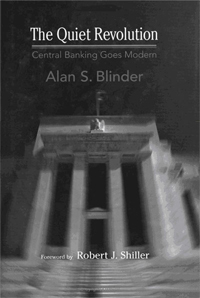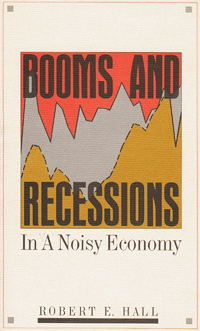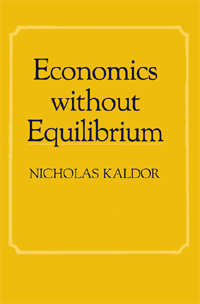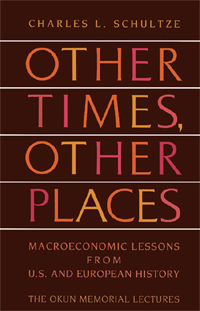Arthur M. Okun Memorial Lectures Books
 Alan S. Blinder, The Quiet Revolution: Central Banking Goes Modern. New Haven: Yale University Press, 2004
Alan S. Blinder, The Quiet Revolution: Central Banking Goes Modern. New Haven: Yale University Press, 2004
Foreword by Robert J. Shiller
The "quiet revolution" that has taken place in central banking around the world in recent years represents changes in both procedure and substance. Alan Blinder describes changes in central bank procedures that underlie monetary policy: changes in public relations, in bureaucratic structure, and in the use of financial data. And yet, as he shows, the procedural changes are very much related to changes of substance, for the procedure influences the efficacy of monetary policy and answers some of the deepest concerns of central bankers.
Progress in the formulation of monetary policy appears to involve changes in procedure rather than in formulaic responses to economic conditions since the problem of maintaining an effective monetary policy is so subtle. There is fundamental uncertainty about the future course of the economy, about the public's interpretations of and reactions to monetary policy measures, and about possible political and social pressures. There is even disagreement about how to interpret basic monetary policy objectives. Because of these subtleties, central banking has widely been described as an art rather than a science.
In 1932, Sir Ralph Hawtrey gave an account of this subtlety in his classic The Art of Central Banking. He argued that, despite fundamental uncertainty, central banking ought yet really to have a scholarly, if not a scientific, foundation: "But it is a special characteristic of the art of central banking that it deals specifically with the task of an authority directly entrusted with the promotion of human welfare. Human welfare, human motives, human behaviour supply material so baffling and elusive that many people are sceptical of the possibility of building a scientific edifice on so shifting a foundation. But however complex the material, and however imperfect the data, there is always an advantage to be gained from systematic thought" (R.G. Hawtrey, The Art of Central Banking [London: Longmans Green, 1932], vi–vii). Professor Blinder's book is a perfect example of the systematic thought that Hawtrey would have endorsed.
The progress that Blinder details in this book has perhaps been slow, since the critical experiences, monetary crises, or economic problems as well as the outcomes of central bank policies are themselves slow to reveal themselves. But the progress, informed as it has been by both scholarly and practitioner insights, has been very important, ultimately, to human welfare. Blinder here shows an excellent fed for the nature of this progress, tying it to specific policy concerns and to issues of economic theory:
One long-standing procedural problem for monetary policy-makers is deciding what central bankers ought to tell the public. It is a difficult problem because it is hard to say how we can expect the public to react to central bank pronouncements. Since financial market reactions are fundamentally tied to investor expectations, and the functioning of the economy is connected with public confidence, central bankers have long perceived that they had best keep their thinking a secret and issue only the most carefully worded statements. Now, a consensus appears to be emerging that it is better for central bankers to be open with the public, Blinder offers a rationale for this consensus and some refinements about just what central hankers should he telling the public.
Another such problem for monetary poi icy makers is how to deal with the fundamental differences of opinion and objectives of people connected with the central bank itself. There is no agreement on an economic model, there is no agreement on the nature of economic conditions at any time, and there is no agreement even on how monetary policy success should be measured. Formulating good central banking policy requires some appreciation of the disagreement. It appears, from both practical evidence and experimental evidence that Blinder has created, that committees deal with the monetary policy problem better than individuals do and are not, as some have claimed, slow to react. The world's central banks arc already heeding such evidence, and we arc entering a time when central bankers are members of committees and administer policies that come not just from their own individual minds but instead from an interaction of many minds.
Yet another problem is discerning how much central bankers should respect the valuations expressed in financial markets. When Hawtrey wrote, central bankers often took a supercilious attitude toward these markets, acting as if they thought they had superior knowledge about the mass of herd behavior in the markets. Central bankers were then thought by many to be moral leaders a much as popes and philosophers. Many still view them in this way, but the mystique that central bankers have had has receded somewhat. Then the efficient markets revolution appeared in finance, and the efficient markets hypothesis took the academic profession by storm starting in the 1970s. In the 1990s, central bankers tended to respect markets too much, not even recognizing the stock market bubble of the 1990s, the biggest since the 1920s. Blinder here remarks on the advantages of respecting markets but then argues for a more balanced policy.
Overall, central banking has been getting much better through time. One might say that a new central banking technology has been evolving, for one can rightly call important procedures a technology, and these can make for better coop)l of the world's economies. Personal judgment of market conditions will always play a fundamental role, but the way the judgment is translated into actions has been improved.
Blinder raised some of the difficult issues facing formulators of monetary policy in his earlier book Hard Heads, Soft Hearts: Tough-Minded Economics for a Just Society (Reading, Mass.: Addison-Wesley, 1987), and he gave there an important characterization of sensible and humane stabilization policy. He downplayed the importance of inflation relative to unemployment, asserting that a "gross misunderstanding blows the political importance of inflation out of all proportion to its economic importance" (51). He brought these views with him when he became vice-chairman of the U.S. Federal Reserve Board in 1994, and these led him into a bit of conflict with a strong and highly regarded Fed chairman, Alan Greenspan.
As detailed in the book by Bob Woodward, Maestro: Greenspan's Fed and the American Boom (New York: Simon and Schuster, 2000), Blinder learned at that time how difficult it can be to steer monetary policy in a new direction. Blinder not only resisted excessive tightening; he also pursued a new openness to monetary policy. He successfully advocated that the Federal Open Markets Committee should make a statement to accompany a decision to change interest rates, and he himself while vice-chairman flaunted precedent by discussing openly in public forums his views about monetary policy. But he quickly discovered the consequences of such actions when the institutional assumptions in the central bank do not support such candor and when the chairman is not fully behind it. Sensing the diminution of his influence as vice-chairman at the Fed, Blinder announced in 1996 that he would leave his post.
But he has not abandoned his commitment to fostering good monetary policy. Blinder's efforts to advance the cause of good monetary policy have led to new insights about the achievement of the ultimate objectives of monetary policy. This book will be remembered as an important treatise on the practice of central banking.
A word about the Okun Lecture series is in order. These lectures are named in honor of the late Arthur Okun, erstwhile Yale economics professor. Professor Okun, like Professor Blinder, entered Washington via the Council of Economic Advisers, and he, like Blinder, left his mark on Washington policymakers, Arthur Okun left Yale for a staff position on President Kennedy's Council Economic Advisers in 1962. He became a council member in 1964, and chairman in 1966.
The anonymous donor for the Arthur Okun Memorial Lecture Series described his admiration for Arthur Okun and the intention of this lecture series in these terms:
Arthur Okun combined his special gifts as an analytical and theoretical economist with his great concern for the well-being of his fellow citizens into a thoughtful, pragmatic, and sustaining contribution to his nation's public policy.
Extraordinarily modest personally, he was a delightful and trenchant activist on behalf of others — both as members of our whole society and as individuals. He touched many, many people in ways they will always cherish.
Offered in affectionate appreciation of Art's gifts, this lecture series seeks to recognize and encourage professional economists to search for policies that will contribute to the betterment of life and living.
Arthur Okun would have been fascinated by The Quiet Revolution, and it is a fitting addition to the series of Okun lectures.
 Robert E. Hall, Booms and Recessions in a Noisy Economy. New Haven: Yale University Press, 1991
Robert E. Hall, Booms and Recessions in a Noisy Economy. New Haven: Yale University Press, 1991
Preface
It is an honor to help commemorate Arthur Okun's many contributions to macroeconomics. I cannot say that he would have approved of everything that I will say here, any more than he fully approved of the various papers of mine that went through his detailed scrutiny at the Brookings Institution in the 1970s. I can say that Art would have welcomed a debate on these topics, would have taken all viewpoints seriously, and would have made many helpful contributions to my work. Even when Art disagreed with me most vehemently, he never failed to suggest improvements in logic and exposition. He was always on the side of sound economics.
The ideas in these lectures have been taking form in my mind for a number of years. Since 1985 I have been working on a research program on the macroeconomic implications of imperfect markets, and the influence of that work will be obvious. My interest in intertemporal substitution has been much longer standing, though the idea that increasing returns augments intertemporal substitution is relatively new.
I can trace the awakening of my interest in temporal agglomeration specifically to Valerie Ramey's dissertation, and I am grateful to her for many helpful discussions of this topic. Peter Diamond's and Richard Rogerson's ideas have also had an important effect on my thinking on this subject. Russell Cooper offered additional help on this point during his visit to the Hoover Institution in 1987-88.
The London School of Economics and the Massachusetts Institute of Technology provided opportunities to present early versions of these lectures. Mark Bils, Olivier Blanchard, Jeffrey Miron, and many others in those audiences provided helpful comments.
Steven Durlauf, my colleague in the Department of Economics at Stanford University, was enormously helpful on the noise measurement issue. Our discussions led to a joint paper on this subject.
 Nicholas Kaldor, Economics without Equilibrium. New York: M. E. Sharp, Inc., 1985
Nicholas Kaldor, Economics without Equilibrium. New York: M. E. Sharp, Inc., 1985
Preface by James Tobin
Nicholas Lord Kaldor delivered these three lectures at Yale University in October 1983, the first of a series in memory of Arthur M. Okun, who died suddenly, tragically prematurely, on March 23, 1980, at the age of 51.
The Arthur M. Okun Memorial Lectures have been made possible by gifts to Yale by an alumnus who was a long-time friend and admirer of Okun. The donor has stated the reasons for the series in these words:
Arthur Okun combined his special gifts as an analytical and theoretical economist with his great concern for the well-being of his fellow citizens into a thoughtful, pragmatic, and sustaining contribution to his nation's public policy.
Extraordinarily modest personally, he was a delightful and trenchant activist on behalf of others — both as members of our whole society and as individuals. He touched many, many people in ways they will always cherish.
Offered in affectionate appreciation of Art's gifts, this lecture series seeks to recognize and encourage professional economists to search for policies that will contribute to the betterment of life and living.
Art Okun was a member of the Yale economics faculty from 1951 to 1969, although from the fall of 1961 he was mostly on leave for public service in Washington. When he came to Yale, he was completing his Ph.D. dissertation from Columbia, where he received his B.A. in 1949 and Ph.D. in 1956. He quickly became a bulwark of the Yale economics department, an intellectual and institutional leader.
Art was a marvelous and generous teacher and colleague. His office — door always open — was the place to go to get things straight, confusions dispelled, errors corrected, questions sensibly posed, models repaired. A thinker of natural integrity and inexhaustible curiosity, he pursued matters in depth, unsatisfied until logic was tight and facts fell into place. Patient and considerate in classroom and out, he could always find and foster some kernel of merit in even the most unpromising questions or comments.
In 1961 Art Okun joined the staff of President Kennedy's Council of Economic Advisers and began a brilliant career of public service. He returned to academia in fall 1963, but a year later President Johnson appointed him a Member of the Council, of which he became Chairman in 1968. When administrations changed in 1969, Okun resigned his Yale professorship and joined the Brookings Institution in Washington as a Senior Fellow.
At Brookings much of his energy and leadership went into his brainchild, the Brookings Panel on Economic Activity, which enlisted able theorists and econometricians from Brookings and elsewhere for research on the major macroeconomic events and policy issues of the day. The papers were published in Brookings Papers on Economic Activity, which under the painstaking editorship of Okun and George Perry became one of the most admired professional journals in economics. Art had organized a special meeting of the Panel and a special issue of BPEA for their tenth anniversary in 1980, but he did not live to take part.
Arthur Okun was a great economist, unerring in his intuition and his perception of the core of a problem or the essence of an argument. His unique chemistry compounded theory, insight, and hard-won fact into miracles of revelation. His expositions, even of difficult material, were models of clarity, grace, humor, and style. In the architecture and practice of economic policy he was simultaneously innovative and prudent. Both as scholar and policy-maker he was not only a realist but a humanist, unwavering in his conviction that economics and its applications could and should improve the welfare of actual human beings, mainly those who start the competitive race far behind.
No one could have been more fitting for the first lectures of the series than Lord Kaldor, one of the truly great economists of the world in this century. The committee charged with responsibility for the series, and the faculty and students of economics and other disciplines, were delighted that Lord Kaldor honored Yale and the memory of Arthur Okun by accepting our invitation.
Throughout a long and productive career Lord Kaldor has combined original and insightful innovations in economic theory, imaginative and pragmatic policy proposals, and distinguished public service. Like Okun, Kaldor has always sought to harness the art and science of economics to the betterment of the human condition. His bases have been London and the older Cambridge, but his interests and influence have covered the world. Like Okun, Kaldor has always been a free spirit and an independent mind, resisting classification in any "school" or ideology.
The reader will see that Lord Kaldor made a special point of relating his own views of economic process to those of Okun, particularly the theory of markets set forth in Okun's magnum opus, Prices and Quantities, posthumously published. Both Kaldor and Okun regard the standard price-cleared auction market model of the economy as unrealistic and therefore seriously misleading in its macroeconomic implications. Kaldor's lectures are a cogent critique of the standard model and an outline of the elements of a more relevant model, which can provide a solid microeconomic foundation for Keynesian macroeconomics.
Lord Kaldor's lectures drew a large, attentive, and enthusiastic audience at Yale. They deserve a much wider audience. We at Yale are proud to have the lectures in print, and we are grateful to M.E. Sharpe, Inc. for publishing them.
 Charles E. Schultze, Other Times, Other Places: Macroeconomic Lessons from U.S. and European History. Washington, DC: Brookings Institution, c1986
Charles E. Schultze, Other Times, Other Places: Macroeconomic Lessons from U.S. and European History. Washington, DC: Brookings Institution, c1986
Foreword by James Tobin
Most of the research aimed at finding predictable regularities in macroeconomic behavior, or illuminating some proposition in economic theory, examines the data for one country during one period — usually the years since World War II. In the three lectures that make up this book, Charles L. Schultze, a senior fellow in the Brookings Economic Studies program, compares several aspects of economic behavior in different historical eras and among different countries, and uses the similarities and differences to evaluate some current theoretical controversies and policy issues.
The first lecture compares the behavior of inflation in the United States in the last three decades with that in the years between the Civil War and World War I. From this comparison Schultze draws several conclusions about the nature of inflation and offers some views about its future prospects. The second lecture examines the behavior of real wages in the United States and four European countries during the recent past. Schultze questions the validity of the widely held view that real wages are more rigid in Europe than in the United States and that this rigidity explains the steady rise of European unemployment over the past ten years. The final lecture discusses the reasons that economic stability in the United States since World War II has been so much greater than it was in the late nineteenth and early twentieth centuries.
These lectures, delivered in October 1985, are part of a series established at Yale University in memory of Arthur M. Okun. In his preface to this book, James Tobin describes the series and notes the long, close relationship between Charlie Schultze and Art Okun, who was a senior fellow at Brookings from 1969 until his death in 1980.
The author wishes to thank Martin Neil Baily, Barry P. Bosworth, and George L. Perry for their advice and comments on early drafts of these lectures. Alan S. Blinder read the completed manuscript, made many valuable suggestions, and pointed out several errors that needed correction. Michael T. Thomas and Janet L. Chakarian provided excellent research assistance, Caroline Lalire edited the manuscript, Carolyn A. Rutsch checked it for factual errors, and Anita G. Whitlock typed the original manuscript and guided it through its many revisions. The underlying research was supported by a grant from the Ford Foundation.
The views in this book are solely those of the author and should not be ascribed to the Ford Foundation, to the persons whose assistance is acknowledged above, or to the trustees, officers, or other staff members of the Brookings Institution.
Preface by James Tobin
Charles L. Schultze gave the second Arthur M. Okun Memorial Lectures at Yale University in October 1985. His three lectures are published here, as extended and revised.
The lecture series honors the memory of Arthur M. Okun (1928-80). The donor, a Yale alumnus who was a long-time associate, friend, and admirer of Okun, stated the reasons for the series in these words:
Arthur Okun combined his special gifts as an analytical and theoretical economist with his great concern for the well-being of his fellow citizens into a thoughtful, pragmatic, and sustaining contribution to his nation's public policy.
Extraordinarily modest personally, he was a delightful and trenchant activist on behalf of others — both as members of our whole society and as individuals. He touched many, many people in ways they will always cherish.
Offered in affectionate appreciation of Art's gifts, this lecture series seeks to recognize and encourage professional economists to search for policies that will contribute to the betterment of life and living.
The first Okun lecture, in October 1983, was Nicholas Kaldor. His lectures were published as Economics without Equilibrium (Armonk, NY: M.E. Sharpe, 1985).
Art Okun’s career, after his student years at Columbia, was divided among three institutions, to all of which he was deeply loyal: Yale, the Council of Economic Advisers, and the Brookings Institution.
Like Okun, Charlie Schultze has been an important figure in the Washington economic policy scene. He was a member of the CEA in the 1950s; in 1962 he became assistant director of the Bureau of Budget; from 1965 through 1967 he was director of the Bureau. During the 1960s Art Okun was a member of the CEA and its chairman in the last two years of the Johnson administration. Thus Charlie and Art were close friends and colleagues in the Executive Office of the President, and then from 1969 at Brookings. In 1977 Charlie Schultze returned to the federal government as chairman of President Carter’s Council of Economic Advisers, and we may be sure that re relied heavily on advice and help from Art, across town at Brookings.
It is obviously very fitting that Charlie Schultze give the Okun Lectures. It would be fitting even if Schultze and Okun had not enjoyed such close personal ties for so many years. Throughout his career Schultze has been an economist in the same spirit as Okun, the spirit that the lecture series seeks to honor and to perpetuate. Schultze has always looked for relevant facts and has dug deeply to find them. He has used theory and statistical technique not for their own sakes but as aids in common sense in organizing and understanding the facts. He had continually sought policies and institutions that would improve economic performance. The aspects of economic history and contemporary reality that he has tried to understand always have significant bearing on important issues of policy.
In these three Okun Lectures Schultze once again displays the qualities of his research. He resourcefully exploits U.S. data going back well into the nineteenth century, to help us understand inflation and its inertia, demand fluctuations and unemployment, and monetary policies and regimes. The policy motivation is to describe both the circumstances in which policies for demand stabilization can be constructively used and the limits to their use. He mobilizes data from several European countries to appraise the alleged diagnoses of their stagnation in the 1980s: structural unemployment and real wage rigidity. The moral is that the maladies are overstated, that they are not so severe that demand stimulus could not improve the economic performance of those economies. Finally, Schultze shows that the apparent improvement of U.S. macroeconomic performance since World War II, compared not only with the 1920s and 1930s but also with decades before World War I, is far from a statistical mirage. The trend real growth rate has been higher, and fluctuations have been less severe, with longer cyclical recoveries. Stabilization policies, of which both Schultze and Okun were expert and realistic practitioners, seem to have worked.
The publication of this volume by the Brookings Institution continues the cooperation between Brookings and Yale in undertakings honoring Arthur M. Okun. In September 1981 we both sponsored, together with Columbia University, a symposium in Okun’s memory in New York. Brookings published the proceedings in Macroeconomics: Prices and Quantities in 1983. We at Yale are grateful to Brookings for publishing these lectures, too, and especially for lending us Charlie Schultze for a fruitful week, which included informal interchange with students and faculty as well as the lectures. It was fitting that Matthew Shapiro, who served on the CEA staff under Schultze and is now a faculty member at Yale, smoothly handled the logistics of the visit.